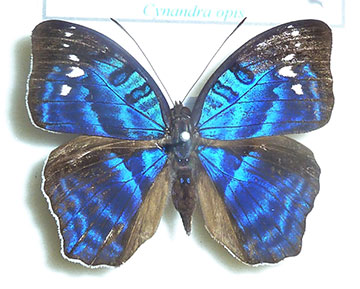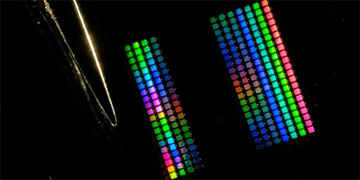
Brilliant nymph (C. opis) in a collection of J. Dobson. [Image: JMK/Wikimedia Commons (CC BY-SA 3.0)]
The wings of the butterfly species Cynandra opis, also known as the brilliant nymph, have markings that appear intensely blue when illuminated and viewed from certain angles. The hue originates from the interaction of visible light with periodic nanostructures on the surface of the wing, a phenomenon known as structural color.
Now, researchers in Switzerland and China have replicated the nanostructures of C. opis using two-photon laser lithography, a type of 3D printing that achieves fabrication in a quick and scalable way (Adv. Mater., doi: 10.1002/adma.202109161). The optical technique could pave the way for easier creation of bio-inspired structural colors for technological applications, such as digital 3D displays and security features on banknotes.
Mimicking butterfly wings
Many studies have closely examined the photonic structures responsible for the striking colors of butterfly wings, but few have attempted to design and fabricate them. One reason is that some species were observed to have very complex 3D structures incorporating networks of ridges and lamellae causing multilayer interference, reflection and diffraction.
“The regular nanostructures on the wings of Cynandra opis, however, were particularly well suited to reconstruction using 3D printing,” said Xiaobao Cao, lead author and former doctoral student at ETH Zurich, in a press release accompanying the research.
The wings of C. opis possess a less intricate pattern called a crossed double-grating. Micron-sized ridges form a periodic array, with ribs of a first grating extending outward to produce a second, underlying diffracting plane. Interference and diffraction effects both contribute to the resulting blue iridescence.
The researchers realized they could employ two-photon laser lithography—an optical 3D printing technique for fabricating microscopic structures with high-resolution features—to create a simplified version of the crossed double-grating.
All visible colors

The two-layer grid under the electron microscope. Left: a detail of a butterfly wing. Right: a portion of the 3D-printed structure. The lattice spacing is around 250 nm. [Image: Cao et al. Advanced Materials 2022]
The team’s two-photon laser lithography system used a femtosecond pulsed laser to illuminate a sample of photoresist on a glass substrate. A high-numerical-aperture lens tightly focused the laser onto the sample, solidifying the photoresist in a layer-by-layer fashion. In this way, the researchers could build bi-grating nanostructures, made up of two grid layers stacked perpendicularly on top of each another, with consistent surface quality and optical performance.
They varied the height and period of the grating features between 250 nm and 1.2 µm, discovering that such changes control the hue and purity of the resulting structural colors. In fact, this range was able to generate all the colors of the visible spectrum.
The researchers believe that two-photon laser lithography could be explored as a route towards large-scale production of nanostructures, given its speed and precision. Next, they plan to generate more complicated nanostructures with the technique—for example, adding disordered features into the bi-grating, which could lead to new and unique optical properties.
